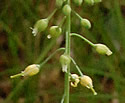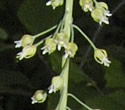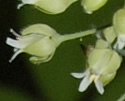Boechera canadensis (Sickle-pod)
| Also known as: | Canadian Rockcress |
|---|---|
| Genus: | Boechera |
| Family: | Brassicaceae (Mustard) |
| Life cycle: | biennial |
| Origin: | native |
| Habitat: | part shade, shade; dry open woods, rocky slopes |
| Bloom season: | May - July |
| Plant height: | 1 to 3 feet |
| Wetland Indicator Status: | none |
| MN county distribution (click map to enlarge): |  |
| National distribution (click map to enlarge): |  |
Pick an image for a larger view. See the glossary for icon descriptions.
Detailed Information
Flower: 

![[photo of flowers]](/udata/r9ndp23q/white/sicklepod_0621_103634-t.jpg) An elongating raceme at the top of the stem and occasional branching stems in the upper part of the plant. Flowers are about ¼ inch long with 4 narrow, blunt-tipped white petals and 6 yellow stamens. The petals are spreading and about half again as long as the 4 sepals that form a round cup at the base of the flower. Each flower is on a long slender sparsely hairy stalk.
An elongating raceme at the top of the stem and occasional branching stems in the upper part of the plant. Flowers are about ¼ inch long with 4 narrow, blunt-tipped white petals and 6 yellow stamens. The petals are spreading and about half again as long as the 4 sepals that form a round cup at the base of the flower. Each flower is on a long slender sparsely hairy stalk.
Leaves and stem: 


![[photo of leaves]](/udata/r9ndp23q/white/sicklepod_0621_110817-t.jpg) Stem leaves are 1 to 4 inches long, to 1 inch wide, pointed at the tip and tapering at the base, hairy to varying degrees, with irregular fine teeth and no leaf stalk, becoming smaller as they ascend the stem. Basal leaves are stalked, more spatula shaped and may have a few shallow lobes; they typically shrivel up by flowering time. The stem is typically hairy near the base and hairless in the upper part of the plant.
Stem leaves are 1 to 4 inches long, to 1 inch wide, pointed at the tip and tapering at the base, hairy to varying degrees, with irregular fine teeth and no leaf stalk, becoming smaller as they ascend the stem. Basal leaves are stalked, more spatula shaped and may have a few shallow lobes; they typically shrivel up by flowering time. The stem is typically hairy near the base and hairless in the upper part of the plant.
Fruit: 
![[photo of fruit]](/udata/r9ndp23q/white/sicklepod_0802_113023-t.jpg) Fruit is a slender, flattened scythe-shaped pod 3 to 4 inches long, containing a single row of seeds. The pods are more or less straight and horizontal when first forming, then become curved and drooping.
Fruit is a slender, flattened scythe-shaped pod 3 to 4 inches long, containing a single row of seeds. The pods are more or less straight and horizontal when first forming, then become curved and drooping.
![[photo of seed]](/udata/r9ndp23q/pd/arabis-canadensis-1-t.jpg) The small seeds are egg to heart-shaped and winged with a fine papery wrapping that help carry them off in the wind.
The small seeds are egg to heart-shaped and winged with a fine papery wrapping that help carry them off in the wind.
Notes:
Sicklepod is more commonly known as Arabis canadensis, but recent DNA testing has moved it to genus Broechera. Sicklepod does not typically form colonies—I don't think I've ever seen more than a couple plants together in any location. They tend to be widely scattered. Many plants (formerly) in the Arabis genus are similar in overall structure with similar flowers. Sicklepod is distinguished by the leaf shape, narrow spreading flower petals that are about half again as long as the sepals, and the flattened curved pods. Spreading-pod Rockcress (Boechera grahamii, or Arabis divaricarpa) is the most common rockcress in Minnesota and probably the most likely to be confused with Sicklepod. The former has much larger petals on the flowers, and the fruit remains mostly horizontal, not drooping like Sicklepod.Native Plant Nurseries, Restoration and Landscaping Services ↓
More photos
Photos by K. Chayka taken at Wild River State Park, Chisago county. Photos by Peter M. Dziuk taken in Winona county.
Comments
Have you seen this plant in Minnesota, or have any other comments about it?
on: 2013-07-26 23:25:45
Williams Nature Preserve
on: 2014-07-13 00:16:22
This plant was in flower on a partly-shaded slope (an oak savanna restoration area)at Ottawa Bluffs Preserve (The Nature Conservancy)in Le Sueur County on June 19. It was in both flower (toward ending) and fruit during a visit on July 3.







 Sicke-pod plant
Sicke-pod plant  more plants
more plants more flowers
more flowers